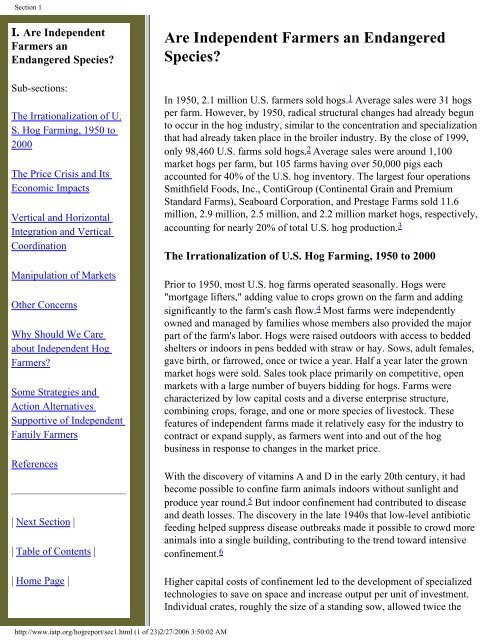IATP Hog Report - Institute for Agriculture and Trade Policy
IATP Hog Report - Institute for Agriculture and Trade Policy
IATP Hog Report - Institute for Agriculture and Trade Policy
Create successful ePaper yourself
Turn your PDF publications into a flip-book with our unique Google optimized e-Paper software.
Section 1<br />
I. Are Independent<br />
Farmers an<br />
Endangered Species?<br />
Sub-sections:<br />
The Irrationalization of U.<br />
S. <strong>Hog</strong> Farming, 1950 to<br />
2000<br />
The Price Crisis <strong>and</strong> Its<br />
Economic Impacts<br />
Vertical <strong>and</strong> Horizontal<br />
Integration <strong>and</strong> Vertical<br />
Coordination<br />
Manipulation of Markets<br />
Other Concerns<br />
Why Should We Care<br />
about Independent <strong>Hog</strong><br />
Farmers?<br />
Some Strategies <strong>and</strong><br />
Action Alternatives<br />
Supportive of Independent<br />
Family Farmers<br />
References<br />
| Next Section |<br />
| Table of Contents |<br />
| Home Page |<br />
Are Independent Farmers an Endangered<br />
Species?<br />
In 1950, 2.1 million U.S. farmers sold hogs. 1 Average sales were 31 hogs<br />
per farm. However, by 1950, radical structural changes had already begun<br />
to occur in the hog industry, similar to the concentration <strong>and</strong> specialization<br />
that had already taken place in the broiler industry. By the close of 1999,<br />
only 98,460 U.S. farms sold hogs. 2 Average sales were around 1,100<br />
market hogs per farm, but 105 farms having over 50,000 pigs each<br />
accounted <strong>for</strong> 40% of the U.S. hog inventory. The largest four operations<br />
Smithfield Foods, Inc., ContiGroup (Continental Grain <strong>and</strong> Premium<br />
St<strong>and</strong>ard Farms), Seaboard Corporation, <strong>and</strong> Prestage Farms sold 11.6<br />
million, 2.9 million, 2.5 million, <strong>and</strong> 2.2 million market hogs, respectively,<br />
accounting <strong>for</strong> nearly 20% of total U.S. hog production. 3<br />
The Irrationalization of U.S. <strong>Hog</strong> Farming, 1950 to 2000<br />
Prior to 1950, most U.S. hog farms operated seasonally. <strong>Hog</strong>s were<br />
"mortgage lifters," adding value to crops grown on the farm <strong>and</strong> adding<br />
significantly to the farm's cash flow. 4 Most farms were independently<br />
owned <strong>and</strong> managed by families whose members also provided the major<br />
part of the farm's labor. <strong>Hog</strong>s were raised outdoors with access to bedded<br />
shelters or indoors in pens bedded with straw or hay. Sows, adult females,<br />
gave birth, or farrowed, once or twice a year. Half a year later the grown<br />
market hogs were sold. Sales took place primarily on competitive, open<br />
markets with a large number of buyers bidding <strong>for</strong> hogs. Farms were<br />
characterized by low capital costs <strong>and</strong> a diverse enterprise structure,<br />
combining crops, <strong>for</strong>age, <strong>and</strong> one or more species of livestock. These<br />
features of independent farms made it relatively easy <strong>for</strong> the industry to<br />
contract or exp<strong>and</strong> supply, as farmers went into <strong>and</strong> out of the hog<br />
business in response to changes in the market price.<br />
With the discovery of vitamins A <strong>and</strong> D in the early 20th century, it had<br />
become possible to confine farm animals indoors without sunlight <strong>and</strong><br />
produce year round. 5 But indoor confinement had contributed to disease<br />
<strong>and</strong> death losses. The discovery in the late 1940s that low-level antibiotic<br />
feeding helped suppress disease outbreaks made it possible to crowd more<br />
animals into a single building, contributing to the trend toward intensive<br />
confinement. 6<br />
Higher capital costs of confinement led to the development of specialized<br />
technologies to save on space <strong>and</strong> increase output per unit of investment.<br />
Individual crates, roughly the size of a st<strong>and</strong>ing sow, allowed twice the<br />
http://www.iatp.org/hogreport/sec1.html (1 of 23)2/27/2006 3:50:02 AM

















